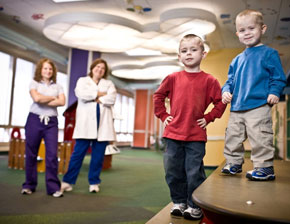Our brain and spinal column are the control center of our body. If these become damaged or altered, it can affect us in a variety of ways. With modern technology, our understanding of these effects is never-ending...
Neurological Diseases In Children
Neurological diseases are those that affect the nervous system of the body which includes the nerves, brain and spinal cord. Depending on the type of injury related to the nervous system, the neurological diseases in children can cause symptoms like intellectual problems, issues with hearing and seeing, speech problems, movement disorders, etc. While some of these are genetic and inherited from either parent, others are those that develop either during pregnancy or birth or even childhood. Some of common neurological diseases in children include autism, ADHD or attention deficit hyperactivity disorder, traumatic brain injury and cerebral palsy.
Characteristics or symptoms of neurological diseases in children:
The kind of symptoms that are produced by different conditions depend on the condition.
- With ADHD, a child has problems with concentration and becomes restless.
- Autism, on the other hand is characterized by restricted interests, repetitive actions and impaired communication skills. Children who have this neurological disorder find it difficult to maintain eye contact and have problems with social interaction, nonverbal communication and speech.
- Cerebral Palsy is actually a collective group of neurological conditions which are caused due to brain damage. This affects the muscle tone and body movement of children who have this disease. Symptoms include difficulties in eating, changing clothes, walking and involving in common activities.
- TBI or traumatic brain injury is caused due to brain damages that occur from external forces. It is characterized by symptoms which actually vary with the portion of the brain that is affected and they include problems with thinking, hearing, seeing, speaking and movement.
Causes of Neurological Diseases in Children:
The causes of these diseases vary with the conditions.
- TBI occurs due to external brain injury, while autism and ADHD are believed to be caused due to combination of environmental and genetic factors.
- Investigation on the specific mechanisms causing the various disorders is still being carried out by scientists.
Onset:
The onset of different neurological diseases varies according to different conditions. While a child develops cerebral palsy during pregnancy itself or during childbirth or in childhood, in most of the cases, autism makes its appearance before the child turns three years of age. ADHD shows its characteristics before the child turns seven and in the case of TBI, they occur mostly in adolescence or early adulthood.
Prevalence of the common neurological diseases in children:
Prevalence:
- The statistics based on a review research done in January 2007 say that autism affects 2 out of every 1000 children and so is the rate of cerebral palsy.
- 34 in every 1000 children are affected by ADHD and it occurs mainly in children between the age of 0 and 14.
Treatment:
The type and severity of the neurological condition is what becomes the factor which determines the kind of treatment has to be rendered to the affected child.
- The different modes of intervention include surgery, medication, physical therapy, psychotherapy and speech therapy.
- Different devices like braces, wheelchairs, eyeglasses, etc can aid to assist the child suffering from certain deficiencies.

- Home
- Acupuncture Therapy For Neurological Diseases
- Chronic Neurological Diseases
- Common Neurological Diseases
- Degenerative Neurological Diseases
- Equine Neurological Diseases
- Fatal Neurological Diseases
- Genetic Neurological Diseases
- Hereditary Neurological Diseases
- List Of Neurological Diseases
- Most Common Neurological Diseases
- Neuro-Infectious Diseases
- Neurological Autoimmune Diseases
- Neurological Degenerative Diseases
- Neurological Diseases In Children
- Neurological Diseases In Dogs
- Neurological Diseases In Horses
- Neurological Disorders Brain Diseases
- Neurological Genetic Diseases
- Neurological Symptoms
- Neurological System Disorders
- Pediatric Neurological Diseases
- Rare Neurological Diseases
- Symptoms Of Neurological Diseases
- Treatment Of Neurological Diseases
- Types Of Neurological Diseases
